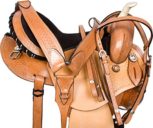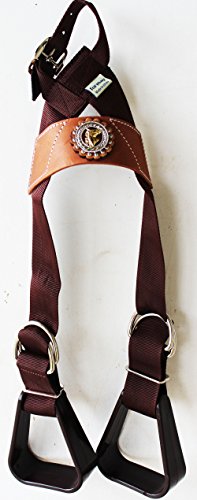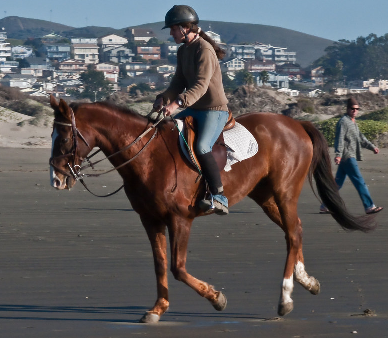The morning pony might go out with four to eight horses, depending on each racehorse’s needs. He might also take the racehorses through the paddock or bring them to the starting gate for schooling.
“Each horse can take between 15 and 45 minutes per set,” says Arena. “When the track closes at 10 a.m., it is time for a warm shampoo.”
Once dry, it’s lunchtime for the ponies. Arena would tack up her afternoon pony well before the first race, which can start anywhere from noon to 2 p.m., depending on the track and the time of year. An afternoon pony can work up to as many races as are on each day’s card, usually eight, and however many days a week the racetrack runs, usually three to five. Between races Arena gave her pony time to rest and drink water in the shade.
“A lot of race fans bring the pony horses carrots and apples to snack on between each race,” says Arena. “So the ponies really look forward to getting treats while they wait for the horses to come out of the paddock.”
Training and Retraining
Some racehorses first learn to pony at the farm where they are started under saddle, while others get their first ponying lessons at the track. Ponying a horse without rider or tack is also a way to start getting a young horse fit.
Arena has worked with trainers to teach racehorses how to pony.
“Some horses are difficult to teach, especially young colts who are exceptionally studdish,” she says. “You have to take baby steps in teaching certain horses how to pony, and I usually start by walking (my pony) on the left side of the racehorse and slightly in front so that the racehorse’s head is adjacent to my hip.”
As the racehorse becomes used to that, Arena gradually introduces the leather pony strap, putting it through the bit and making light contact. Usually the racehorse learns to be led easily, especially since it has likely had many leading lessons on the ground.
“Occasionally, a horse will panic and try to get away from the light pressure,” says Arena. “So you have to be very careful not to work too quickly or be rough.”
Arena has also retrained racehorses to become pony horses. That process starts with careful selection of the individual. Pony horses are almost always geldings because they are calmer with a racehorse than a stud or a mare. Plus, because many racehorses are still colts, they are more likely to keep their minds on racing next to a gelded pony horse.
Top Attributes
Arena wants a well-conformed horse for soundness because pony horses must travel many miles daily. She also looks for mounts that aren’t reactive to other horses.
“Most horses react in a chain: Monkey see, monkey do,” Arena says. “When a racehorse gets nervous Marcel stays calm. He doesn’t react to noises in the grandstand or most things that would spook a horse in general.”
At last year’s Breeders’ Cup, the Marine Corps marching band, complete with giant flags, walked directly in front of Arena and Marcel. Though Marcel had never seen a band before, he stood quietly.
“He also doesn’t mind another horse getting into his personal space,” says Arena.
This is crucial for a pony horse, who must gallop right next to and against the racehorse, sometimes with the horse bumping into his right side or his hindquarters.
“A great pony horse will learn to push the racehorse back and establish a certain dominance without being physically aggressive,” says Arena.
She uses principles of dressage in her retraining, noting that Marcel could perform a second-level dressage test.
“A great pony horse travels with loose contact on the bit and listens to light cues from the rider’s seat and pressure from both the upper and lower leg,” says Arena. “I occasionally have to drop the reins while ponying, and my horse needs to maintain the same pace, speed up rapidly or slow in a hurry, move laterally, and even stop suddenly, depending on what the racehorse decides to do.”
And a good pony horse will anticipate what a racehorse will do.
They’re Athletes, Too
As with any athletic horse, Arena monitors Marcel’s health vigilantly, especially his legs, to catch any problems early. Taking good care of a pony pays dividends, as many can work well into their 20s.
“The horses seem to appreciate their job and purpose,” says Arena. “Most certainly wouldn’t behave so well and help their riders so much if they didn’t like the job.”










Comments
Comments are disabled for this post.